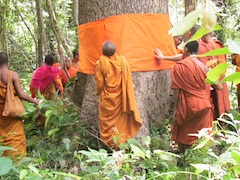ARC and Oxford University's Biodiversity Institute collaborate to map the world's sacred forests
 |
 |
 |
Buddhist monks ‘ordain’ trees in Cambodia in order to confer holy protection upon them. In 2010 the monks won the United Nations’ Equator Prize for their efforts to safeguard Cambodia’s biggest community forest. |
ARC is working with Oxford University's Biodiversity Institute to map the extent of sacred forests and document where they fall within areas of high biodiversity.
Faith views and practices have an enormous impact on the state of the world's forests. The faiths own approximately 5% of the world's forests but influence far more in terms of use and management.
The Oxford researchers estimate that about 15% of the world’s surface is ‘sacred land’ – land that has ‘sacred’ connotations rather than being necessarily owned by faith communities.
High levels of biodiversity
In 2005, an ARC-WWF report, Beyond Belief, found sacred groves are some of the oldest forms of forest protection in the world, with high levels of biodiversity, yet the powerful role of faith beliefs and practices in maintaining forests is often overlooked by both secular and faith groups alike.
Oxford University's mapping project is being carried out in partnership with the World Database on Sacred Natural Sites and aims to establish the extent of faith forestry holdings and influence around the world for the first time.
The project will scientifically measure the coverage of religious and sacred land as well as assess its value in terms of biodiversity and land use by the local community, with the ultimate aim of creating an evidence-based database.
The researchers will work with groups of many different faiths: those who manage the sacred groves in India, the Shinto shrines in Japan, and the Ethiopian Orthodox Church, which owns 300 fragments of forest including the last remnants of Afro-montane tropical forest containing rare and endangered insects.
The religious sites appear to contain a high proportion of species that feature on the Red List of threatened species produced by the International Union for Conservation of Nature (IUCN).
More information
Read Oxford University's press release on the project here.
The map is very much a work in process but you can take a look at it on the Religious Forest Sites website here.
Articles in the press
The mapping project has been attracting some attention in the press. Read more about it in:
The Guardian here.
The Times of India here.
The Treehugger website here.
|

